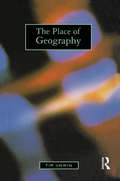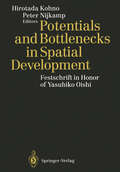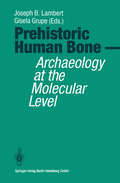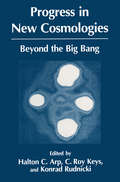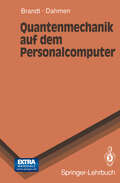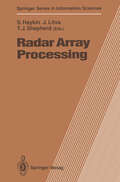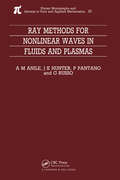- Table View
- List View
Place and the Politics of Identity
by Michael Keith Steve PileIn the last two decades, new political subjects have been created through the actions of the new social movements; often by asserting the unfixed and `overdetermined' character of identity. Further, in attempting to avoid essentialism, people have frequently looked to their territorial roots to establish their constituency. A cultural politics of resistance, as exemplified by Black politics, feminism, and gay liberation, has developed struggles to turn sites of oppression and discrimintion into spaces of resistance. This book collects together perspectives which challenge received notions of geography; which are in danger of becoming anachronisms, without a language to articulate the new space of resistance, the new politics of identity.
Place and the Politics of Identity
by Michael Keith Steve PileIn the last two decades, new political subjects have been created through the actions of the new social movements; often by asserting the unfixed and `overdetermined' character of identity. Further, in attempting to avoid essentialism, people have frequently looked to their territorial roots to establish their constituency. A cultural politics of resistance, as exemplified by Black politics, feminism, and gay liberation, has developed struggles to turn sites of oppression and discrimintion into spaces of resistance. This book collects together perspectives which challenge received notions of geography; which are in danger of becoming anachronisms, without a language to articulate the new space of resistance, the new politics of identity.
Place/Culture/Representation
by James S. Duncan David LeySpatial and cultural analysis have recently found much common ground, focusing in particular on the nature of the city. Place/Culture/Representation brings together new and established voices involved in the reshaping of cultural geography. The authors argue that as we write our geographies we are not just representing some reality, we are creating meaning. Writing becomes as much about the author as it is about purported geographical reality. The issue becomes not scientific truth as the end but the interpretation of cultural constructions as the means. Discussing authorial power, discourses of the other, texts and textuality, landscape metaphor, the sites of power-knowledge relations and notions of community and the sense of place, the authors explore the ways in which a more fluid and sensitive geographer's art can help us make sense of ourselves and the landscapes and places we inhabit and think about.
Place/Culture/Representation
by James Duncan David LeySpatial and cultural analysis have recently found much common ground, focusing in particular on the nature of the city. Place/Culture/Representation brings together new and established voices involved in the reshaping of cultural geography. The authors argue that as we write our geographies we are not just representing some reality, we are creating meaning. Writing becomes as much about the author as it is about purported geographical reality. The issue becomes not scientific truth as the end but the interpretation of cultural constructions as the means. Discussing authorial power, discourses of the other, texts and textuality, landscape metaphor, the sites of power-knowledge relations and notions of community and the sense of place, the authors explore the ways in which a more fluid and sensitive geographer's art can help us make sense of ourselves and the landscapes and places we inhabit and think about.
The Place of Geography
by Tim UnwinThe Place of Geography is designed to provide a readable and yet challenging account of the emergence of gepgraphy as an academic discipline. It has three particular aims: it seeks to trace the development of geography back to its formal roots in classical antiquity; provides an interpretation of the changes that have taken place in geographical practice within the context of Jurgen Haberma's critical theory; and thirdly, describes how the increasing separation of geography into physical and human parts has been detrimental to our understanding of critical issues concerning the relationship between people and environment.
The Place of Geography
by Tim UnwinThe Place of Geography is designed to provide a readable and yet challenging account of the emergence of gepgraphy as an academic discipline. It has three particular aims: it seeks to trace the development of geography back to its formal roots in classical antiquity; provides an interpretation of the changes that have taken place in geographical practice within the context of Jurgen Haberma's critical theory; and thirdly, describes how the increasing separation of geography into physical and human parts has been detrimental to our understanding of critical issues concerning the relationship between people and environment.
PLANETEN Wanderer im All: Satelliten fotografieren und erforschen neue Welten im Sonnensystem
by Kenneth R. Lang Charles A. Whitney"...besticht durch exzellentes Bildmaterial und Stilsicherheit in der Formulierung... Ein ideales Buch für interessierte Laien und angehende Astronomen." (Westdeutsche Zeitung)
Plasma Waves in the Magnetosphere (Physics and Chemistry in Space #24)
by A.D.M. WalkerThis book is a study of plasma waves which are observed in the earth's magnetosphere. The emphasis is on a thorough, but concise, treatment of the necessary theory and the use of this theory to understand the manifold varieties of waves which are observed by ground-based instruments and by satellites. We restrict our treatment to waves with wavelengths short compared with the spatial scales of the background plasma in the mag netosphere. By so doing we exclude large scale magnetohydrodynamic phenomena such as ULF pulsations in the Pc2-5 ranges. The field is an active one and we cannot hope to discuss every wave phenomenon ever observed in the magnetosphere! We try instead to give a good treatment of phenomena which are well understood, and which illustrate as many different parts of the theory as possible. It is thus hoped to put the reader in a position to understand the current literature. The treatment is aimed at a beginning graduate student in the field but it is hoped that it will also be of use as a reference to established workers. A knowledge of electromagnetic theory and some elementary plasma physics is assumed. The mathematical background required in cludes a knowledge of vector calculus, linear algebra, and Fourier trans form theory encountered in standard undergraduate physics curricula. A reasonable acquaintance with the theory of functions of a complex vari able including contour integration and the residue theorem is assumed.
Potentials and Bottlenecks in Spatial Development: Festschrift in Honor of Yasuhiko Oishi
This book aims to offer refreshing contributions to the analysis of spatial and dynamic systems, with a particular view on bottlenecks in the space-economy. The intermediate development field between potential and bottleneck may be approached from different angles and may be covering different fields, such as the environment, spatial equilibrium, technological innovation. The book brings together new ideas, often in a quantitative context, and has a great relevance for advanced spatial dynamic equilibrium analysis.
Pre-Mesozoic Geology in the Alps
by Prof. Dr. J. F. von Raumer Prof. Dr. Franz NeubauerThe Alps are an arched mountain chain stretching 1500 km between Vienna and Graz in Austria and Genova in Italy. They resulted from the collision of the African and Laurasian plates during Mesozoic and Tertiary times. The high standard of knowledge attained over the last 30 years by the working groups on "Alpine Metamorphism" is well known and helped considerably to recognize pre-Mesozoic elements in the Alps. In Part I of this book the subdivision of the major Alpine units and pre-Mesozoic pal inspastic reconstructions are covered before discussion of the pre-Mesozoic geology in Parts II, III and IV It is understood that the Mesozoic and later events overprinted pre-existing structures veiling the earlier history and the nature of protoliths. Although the Alpine overprint does not facilitate the recognition of older struc tures, pre-Mesozoic basement units were recognized during the first beginnings of geological observations in the Alps, about 200 years ago. Fifty percent of the Alpine domain is underlain by basement units that have been unconformably covered since Permian and Mesozoic times. This basement appears today in a complex pattern among the Alpine structures. The history of their discovery and explanation, parallel with a growing sophistication of research methods, are the subject of the introductory chapter of Part II.
Prediction and Perception of Natural Hazards (Advances in Natural and Technological Hazards Research #2)
by F. Siccardi J. M. Nigg J. NemecThis collection of articles provides a unique overview of the state of the science in the prediction of and response to natural disaster events. The uniqueness of this volume is that it comprises more than just the physical science perspective. For each natural hazard included in this text, social scientists have provided research summaries of how public perceptions are related to the actions that are likely to be undertaken when people are confronted with information about the existence of a natural hazard threat. In this book the reader can find a truly international characterization of both hazard perception and prediction. The American and European contributors provide state-of-the-science overviews of empirically-based research knowledge that expands beyond any national boundaries. This approach has resulted in broader understanding of what is currently known about predicting natural hazard events and predicting how those events, or warnings of them, will be responded to by different types of societies.
Prediction of Interannual Climate Variations (Nato ASI Subseries I: #6)
by J. ShuklaIt has been known for some time that the behavior of the short-term fluctuations of the earth's atmosphere resembles that of a chaotic non-linear dynamical system, and that the day-to-day weather cannot be predicted beyond a few weeks. However, it has also been found that the interactions of the atmosphere with the underlying oceans and the land surfaces can produce fluctuations whose time scales are much longer than the limits of deterministic prediction of weather. It is, therefore, natural to ask whether it is possible that the seasonal and longer time averages of climate fluctuations can be predicted with sufficient skill to be beneficial for social and economic applications, even though the details of the day-to-day weather cannot be predicted beyond a few weeks. The main objective of the workshop was to address this question by assessing the current state of knowledge on predictability of seasonal and interannual climate variability and to investigate various possibilities for its prediction.
Prehistoric Human Bone: Archaeology at the Molecular Level
by GiselaGrupe Joseph B. LambertLocked up within human bone are tantalizing clues concerning the diets consumed by ancient peoples. On the one hand the amounts of certain elementsin bone (strontium, zinc) serve as measures of protein, fiber, and calcium intake. On the other hand, the ratios of carbon isotopes and of nitrogen isotopes provide information on questions of fish vs. meat, herbivore vs. carnivore, or (for animals) browser (shrubs) vs. grazer (grasses). Such information can provide a window on many aspects of prehistoric cultures and can supplement the nonskeletal archaeological record. In addition to these two approaches, the biochemical record in bone from protein and nucleic acids such as DNA serves as a source of nondietary information such as genetic relationships. This volume treats all three subjects.: elemental, isotopic, and biochemical. The foremost experts in the areas provide fundamental descriptions of the techniques, express their concerns over the limitations of the methods, and describe recent applications to archaeological studies.
Products of Random Matrices: in Statistical Physics (Springer Series in Solid-State Sciences #104)
by Andrea Crisanti Giovanni Paladin Angelo VulpianiAt the present moment, after the success of the renormalization group in providing a conceptual framework for studying second-order phase tran sitions, we have a nearly satisfactory understanding of the statistical me chanics of classical systems with a non-random Hamiltonian. The situation is completely different if we consider the theory of systems with a random Hamiltonian or of chaotic dynamical systems. The two fields are connected; in fact, in the latter the effects of deterministic chaos can be modelled by an appropriate stochastic process. Although many interesting results have been obtained in recent years and much progress has been made, we still lack a satisfactory understanding of the extremely wide variety of phenomena which are present in these fields. The study of disordered or chaotic systems is the new frontier where new ideas and techniques are being developed. More interesting and deep results are expected to come in future years. The properties of random matrices and their products form a basic tool, whose importance cannot be underestimated. They playa role as important as Fourier transforms for differential equations. This book is extremely interesting as far as it presents a unified approach for the main results which have been obtained in the study of random ma trices. It will become a reference book for people working in the subject. The book is written by physicists, uses the language of physics and I am sure that many physicists will read it with great pleasure.
Programme und Tools für Erddruck und Erdwiderstand mit gekrümmten und ebenen Gleitflächen: 6 Programme
by Hans O. GüntherProgress in New Cosmologies: Beyond the Big Bang
by H. C. Arp C. R. Keys K. RudnickiThe Hidden Hypotheses Behind the Big Bang It is quite unavoidable that many philosophical a priori assumptions lurk behind the debate between supporters of the Big Bang and the anti-BB camp. The same battle has been waged in physics between the determinists and the opposing viewpoint. Therefore, by way of introduction to this symposium, I would like to discuss, albeit briefly, the many "hypotheses", essentially of a metaphysical nature, which are often used without being clearly stated. The first hypothesis is the idea that the Universe has some origin, or origins. Opposing this is the idea that the Universe is eternal, essentially without beginning, no matter how it might change-the old Platonic system, opposed by an Aristote lian view! Or Pope Pius XII or Abbe Lemaitre or Friedmann versus Einstein or Hoyle or Segal, etc. The second hypothesis is the need for a "minimum of hypotheses" -the sim plicity argument. One is expected to account for all the observations with a mini mum number of hypotheses or assumptions. In other words, the idea is to "save the phenomena", and this has been an imperative since the time of Plato and Aristotle. But numerous contradictions have arisen between the hypotheses and the facts. This has led some scientists to introduce additional entities, such as the cosmologi cal constant, dark matter, galaxy mergers, complicated geometries, and even a rest mass for the photon. Some of the proponents of the latter idea were Einstein, de Broglie, Findlay-Freundlich, and later Vigier and myself.
Quantenmechanik auf dem Personalcomputer (Springer-Lehrbuch)
by Siegmund Brandt Hans D. DahmenQuantenmechanik auf dem Personalcomputer beschreibt das in seiner Art einzigartige interaktive Programm IQ, mit dessen Hilfe man sich die Grundlagen der Quantenmechanik anhand von Graphiken veranschaulichen kann. Die beigefügte 3 1/2'' MS-DOS Diskette enthält drei Programme, die je nach Bedarf ohne Koprozessor, mit Koprozessor oder sogar mit einem 32 bit Prozessor lauffähig sind. In einem ausführlichen Begleittext werden u.a. die Bewegung eines freien Teilchens, gebundene Zustände und Streuung in einer und drei Dimensionen sowie spezielle Funktionen der mathematischen Physik behandelt. Durch freie Wahl der Eingabeparamenter können unterschiedliche Problemstellungen anschaulich gelöst werden. 284 auf das Programm abgestimmte Übungen machen Buch und Programm zu einem unentbehrlichen Studienbegleiter.
Quantitative Data File for Ore Minerals
by A.J. Criddle C.J. Stanleyreviewers, and reported by users of the earlier This third edition (or issue) of the Quantitative Data File for ore minerals (QDF) of the Commission on editions. The result is that 510 species and 125 are Mineralogy of the International Mineralogical compositional or structural variants, or varieties, of Association (COM-IMA) is published, with the species, are represented in QDF3. A large number of support of the Natural History Museum, London, by the entries include data collected from the type Chapman & Hall. It has been greatly revised and specimen of a mineral: these include data extracted enlarged and now includes graphs of the reflectance from the published literature. In this respect, QDF3 spectra for all of its entries. These have been differs from earlier editions. included in response to requests from users of the We have also revised and simplified the notes earlier editions. Also included, for those users concerning X-ray data: no longer are the strongest unfamiliar with the application of such spectra to lines in the powder diffraction pattern quoted, nor mineral identification, are introductory notes, are cell dimensions generally given. Instead, it was illustrated with examples of R spectra. decided to refer to data from the original description, The 635 data sets, which are arranged or to data in the PDF of the JCPDS.
Quantitative Particle Physics: Cargèse 1992 (Nato Science Series B: #311)
by Maurice Lévy Jean-Marc Gérard Jean-Louis Basdevant Maurice Jacob Jean Iliopoulos Raymond GastmansProceedings of a NATO ASI held in Cargese, France, July 20-August 1, 1992
Quantum Probability for Probabilists (Lecture Notes in Mathematics #1538)
by Paul-Andre MeyerThese notes contain all the material accumulated over six years in Strasbourg to teach "Quantum Probability" to myself and to an audience of commutative probabilists. The text, a first version of which appeared in successive volumes of the Seminaire de Probabilite8, has been augmented and carefully rewritten, and translated into international English. Still, it remains true "Lecture Notes" material, and I have resisted suggestions to publish it as a monograph. Being a non-specialist, it is important for me to keep the moderate right to error one has in lectures. The origin of the text also explains the addition "for probabilists" in the title : though much of the material is accessible to the general public, I did not care to redefine Brownian motion or the Ito integral. More precisely than "Quantum Probability" , the main topic is "Quantum Stochastic Calculus" , a field which has recently got official recognition as 81825 in the Math.
Quaternary of Scotland (Geological Conservation Review Series)
by D. G. Sutherland J. E. GordonIn describing the geomorphological heritage of Scotland, this volume offers a remarkable account of how the natural environment responded in terms of landforms, processes and plant communities, to severe climatic change as the Quaternary era progressed over the last two million years. This legacy, as preserved in the 138 nationally important GCR sites described, documents a remarkable diversity of landforms in a relatively small area. The rugged highland contrast with the rolling hills and flat plains found further south, while the western and northern islands, together with the highly-indented coastline add further to the scenic diversity. How this variety of landscapes came into being, the forces which shaped it , and the climatic extremes which drove it, are the themes explored in this volume.
Radar Array Processing (Springer Series in Information Sciences #25)
by Simon Haykin T. V. Ho John Litva J. G. McWhirter A. Nehorai U. Nickel B. Ottersten Terence J. Shepherd B. D. Steinberg P. Stoica M. Viberg Z. ZhuRadar Array Processing presents modern techniques and methods for processingradar signals received by an array of antenna elements. With the recent rapid growth of the technology of hardware for digital signal processing, itis now possible to apply this to radar signals and thus to enlist the full power of sophisticated computational algorithms. Topics covered in detail here include: super-resolution methods of array signal processing as applied to radar, adaptive beam forming for radar, and radar imaging. This book will be of interest to researchers and studentsin the radar community and also in related fields such as sonar, seismology, acoustics and radio astronomy.
Random Media and Boundaries: Unified Theory, Two-Scale Method, and Applications (Springer Series on Wave Phenomena #14)
by Koichi FurutsuFor a system consisting of a random medium with rough boundaries, the governing (Bethe-Salpeter) equation for boundary-value transport problems can be written in a form such that the medium and the boundaries are treatedon an equal footing. This enables several expressions for the solution to be obtained by interchanging the roles of the medium and the boundaries, thus allowing the most convenient one to be selected according to the specific situation and the information required. This book presents a unified theory based on the Bethe-Salpeter equation with particular attention being paid to: boundary-value problems of transport, layer problems, a fixed scatterer imbedded in a bounded random medium, construction of an optical scattering matrix for a complete system, and optical wave propagation in a turbulent medium. The last topic is treated in terms of first moment equations combined with the cluster expansion and, second, the two-scale method based on the Lagrange variational principle.
Raum, Zeit, Materie: Vorlesungen über allgemeine Relativitätstheorie
by Hermann WeylAus dem Vorwort von Jürgen Ehlers zur 7. Auflage: "Die ... Entwicklung der Physik macht verständlich, warum ein so "altes" Werk wie Raum, Zeit, Materie noch aktuell ist: Die Riemann-Einsteinsche Raumzeitstruktur, die von Weyl so meisterhaft beschrieben und aus ihren mathematischen und physikalischen Wurzeln hervorwachsend dargestellt wird, ist immer noch die physikalisch umfassendste und erfolgreichste Raumzeittheorie, die bisher entwickelt und mit der Erfahrung konfrontiert wurde. (...) Als erstes Lehrbuch der noch neuen Theorie setzt es sich gründlicher als spätere Bücher mit den historischen Wurzeln und den sachlichen Motiven auseinander, die zur Einführung der damals neuen Begriffe wie Zusammenhang und Krümmung in die Physik geführt haben. Zweitens ist es von dem vielleicht letzten Universalisten geschrieben worden, der alle wesentlichen Entwicklungen der Mathematik und Physik seiner Zeit nicht nur überblickte, sondern in wesentlichen Teilen mitgestaltete. Das Studium dieses Werkes vermittelt nicht nur die Grundzüge der beiden Relativitätstheorien, sondern zeigt Zusammenhänge mit anderen Ideen, nicht zuletzt auch der Naturphilosophie auf."
Ray Methods for Nonlinear Waves in Fluids and Plasmas (Monographs And Surveys In Pure And Applied Mathematics Ser.)
by Marcelo Anile P Pantano G Russo J HunterPresents in a systematic and unified manner the ray method, in its various forms, for studying nonlinear wave propagation in situations of physical interest, essentially fluid dynamics and plasma physics.


